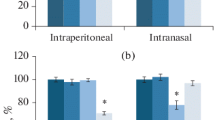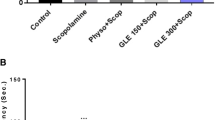Abstract
IT has recently been reported that lysergic acid diethylamide-25 (LSD) has an inhibitory effect on T-maze learning in mice1. The animals were tested 2 min after an intraperitoneal injection of LSD, in view of the observations of Uyeno and Benson that the effect of LSD on agonistic behaviour approaches a maximum 5 min after injection2. Because of the controversy regarding potential long-term psychological effects of LSD, we had undertaken an examination of the effect on learning a shock avoidance task by repeated treatment of mice with increasing quantities of LSD over a long period. We report here the effect of this regimen on Y-maze learning in mice.
Similar content being viewed by others
References
Stasik, J. H., and Kidwell, J. F., Nature, 224, 1224 (1969).
Uyeno, E. T., and Benson, W. M., Psychopharmacologia, 7, 20 (1965).
Cardo, B., J. Physiol. (Paris), 53 (No. 3, Suppl. No. 1), 1 (1961).
Fischer, R. A., and Yates, F., Statistical Tables for Biological, Agricultural and Medical Research, 32 (Oliver and Boyd, London, 1948).
Author information
Authors and Affiliations
Rights and permissions
About this article
Cite this article
MILLER, R., MILLER, E. Lack of a Long-term Effect of LSD on Y-maze Learning in Mice. Nature 228, 1107–1108 (1970). https://doi.org/10.1038/2281107a0
Received:
Revised:
Issue Date:
DOI: https://doi.org/10.1038/2281107a0
- Springer Nature Limited
This article is cited by
-
E2F4-Based Gene Therapy Mitigates the Phenotype of the Alzheimer's Disease Mouse Model 5xFAD
Neurotherapeutics (2021)





